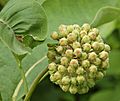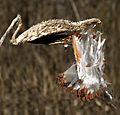Common milkweed facts for kids
Quick facts for kids Common Milkweed |
|
|---|---|
 |
|
| Scientific classification | |
| Kingdom: | |
| (unranked): | |
| (unranked): | |
| (unranked): | |
| Order: | |
| Family: | |
| Subfamily: | |
| Genus: | |
| Species: |
A. syriaca
|
| Binomial name | |
| Asclepias syriaca |
|
Asclepias syriaca, often called Common Milkweed, is a well-known plant. It is also known as the butterfly flower or silkweed. This plant is a type of milkweed. It is native to North America, meaning it naturally grows there. Common Milkweed is very important for many insects, especially Monarch butterflies.
Contents
Where Common Milkweed Grows
Common Milkweed grows in many places across North America. You can often find it in:
This plant likes sunny or partly shaded areas. It can grow in different types of soil, from damp to dry. It usually grows to be about 0.5 to 1.5 meters (1½ to 5 feet) tall.
What Common Milkweed Looks Like
Common Milkweed has several interesting features:
Flowers
Common Milkweed flowers bloom from June to August. They grow in round clusters. The flowers are usually green and purple. They have a sweet smell. These flowers are very attractive to pollinators like bees and butterflies.
Leaves and Stems
The leaves of Common Milkweed are large and oval-shaped. They are usually light green. If you break a leaf or stem, a milky white liquid comes out. This liquid is called latex. It is a defense mechanism for the plant.
Seeds and Pods
After the flowers bloom, they turn into large, green pods. These pods are called follicles. As the pods get older, they turn brown and split open. Inside, there are many flat, brown seeds. Each seed has a silky, white "parachute" attached to it. This silky part helps the seeds float on the wind. This way, the seeds can travel far away and grow new plants.
Why Common Milkweed is Important
Common Milkweed is a very important plant for wildlife.
- Monarch Butterflies: It is the only plant that Monarch butterfly caterpillars can eat. Female Monarch butterflies lay their eggs on milkweed leaves. The caterpillars hatch and eat the leaves to grow. Without milkweed, Monarch butterflies cannot complete their life cycle.
- Other Insects: Many other insects also visit Common Milkweed. Bees, other butterflies, and various bugs feed on its nectar. This makes it a vital part of the ecosystem.
By planting Common Milkweed, people can help support Monarch butterflies and other important pollinators.
Images for kids
See also
In Spanish: Thlalayotl de México para niños









